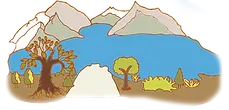ཉིན་བཞི་པ། Day Four
ག་པར།
Where?
Word meaning:
ཚིག་དོན།
ངའི་མིང་ my name, ལ་ to, for, / རྡོ་རྗེ་ Dorje, / ཟེར་གྱི་ཡོད། is called,
ངའི་ my, ནང་ home, / ཝེཊ་ནཱམ་ལ་ in Vietnam, / ཡོད have, །
ངའི་ my, ནང་མི་ family [member], ཚང་མ་ all, / ཝེཊ་ནཱམ་ལ་ in Vietnam, / ཡོད་རེད are there, །
ཝེཊ་ནཱམ་ལ་ in Vietnam, / རི་ mountain, དང་ and, གཙང་པོ་ river, དང་ and, མཚོ་ lake, དང་ and, མཚེའུ་ pond, ལ་སོགས་པ་ and so forth, so on, མང་པོ་ many, / ཡོད་རེད there are, །
ང་ཚོའི་ our, ཁང་པ house, འི་མཁྲིས་ལ་ nearby, ཡང་ also, / མཚེའུ་ pond, གཅིག་ one, / ཡོད་རེད there is, །
མཚེའུ་དེ that pond, འི་ of, ནང་ལ་ in, / ཉ་ fish, འདྲ་མི་འདྲ་ various, མང་པོ་ many, / འདུག there are,
མཚེའུ་དེའི་ནང་ལ་ in that pond, ད་དུང་ even more, moreover, / མེ་ཏོག་པད་མ་ lotus flower, ཡང་ also, / ཡོད་རེད there are, །
མེ་ཏོག་ flower, དེ་ཚོ those, འི་ of, གཡས་གཡོན་ལ་ at around, / བུང་བ་ bee, དང་ and, ཕྱེ་མ་ལེབ་ butterfly, མང་པོ་ many, མཐོང་ see, ཡག་ to, / ཡོད་རེད there are, །
ཝེཊ་ནཱམ་ལ་ in Vietnam, - ས་ཆ་ place, ཚང་མ all, འི་ of, ཡུལ་ལྗོངས་ landscape, / སྐྱིད་པོ་ pleasantful, / ཡོད་རེད are,།
ངའི་མིང་ལ་རྡོ་རྗེ་ཟེར་གྱི་ཡོད།
ངའི་ནང་ཝེཊ་ནཱམ་ལ་ཡོད།

ངའི་ནང་མི་ཚང་མ་ཝེཊ་ནཱམ་ལ་ཡོད་རེད།
![ནང་མི་ _ thành viên gia đình _ family [member]](https://static.wixstatic.com/media/99f364_45a6b1a1ba6a4366a31d1aca50a86e3a~mv2.webp/v1/fill/w_287,h_232,al_c,q_80,usm_0.66_1.00_0.01,enc_avif,quality_auto/%E0%BD%93%E0%BD%84%E0%BC%8B%E0%BD%98%E0%BD%B2%E0%BC%8B%20_%20th%C3%A0nh%20vi%C3%AAn%20gia%20%C4%91%C3%ACnh%20_%20family%20%5Bmember%5D.webp)
ཝེཊ་ནཱམ་ལ་རི་དང་གཙང་པོ་དང་མཚོ་དང་མཚེའུ་ལ་སོགས་པ་མང་པོ་ཡོད་རེད།
ང་ཚོའི་ཁང་པའི་མཁྲིས་ལ་ཡང་མཚེའུ་གཅིག་ཡོད་རེད།
མཚེའུ་དེའི་ནང་ལ་ཉ་འདྲ་མི་འདྲ་མང་པོ་འདུག

མཚེའུ་དེའི་ནང་ལ་ད་དུང་མེ་ཏོག་པད་མ་ཡང་ཡོད་རེད།
མེ་ཏོག་དེ་ཚོའི་གཡས་གཡོན་ལ་བུང་བ་དང་ཕྱེ་མ་ལེབ་མང་པོ་མཐོང་ཡག་ཡོད་རེད།

ཝེཊ་ནཱམ་ལ་ས་ཆ་ཚང་མའི་ཡུལ་ལྗོངས་སྐྱིད་པོ་ཡོད་རེད།

-
གླེང་མོལ། Conversation:
A: ཁོང་གི་མིང་ his/her name, ལ་ to, for, / པད་མ་ Pema, / ཟེར་གྱི་ཡོད་རེད་པས is called?, །
B: ཡོད་མ་རེད No, ། ཁོང་གི་མིང་ his/her name, ལ་ to, for, / རྡོ་རྗེ་ Dorje, / ཟེར་གྱི་ཡོད་རེད is called, །
A: ཁོང་གི་ his/her, ནང་ home, / ག་པར་ where, / ཡོད་རེད is, །
B: ཁོང་གི་ནང་ his/her home, / ཝེཊ་ནཱམ་ལ་ in Vietnam, / ཡོད་རེད is, །
A: ཁོང་གི་ his/her, ནང་མི་ family [member], / ཕྱི་རྒྱལ་ abroad, ལ་ in, / ཡོད་རེད་ are, པས ?, །
B: ཡོད་མ་རེད། No, ཁོང་གི་ནང་མི་ his/her family, ཚང་མ་ all, / ཝེཊ་ནཱམ་ལ་ in Vietnam, / ཡོད་རེད are, །
A: ཁོང་ཚོའི་ their, ཁང་པ house, འི་ of, མཁྲིས་ལ་ nearby, / ག་རེ་ what, / ཡོད་ there, རེད is, །
B: ཁོང་ཚོའི་ཁང་པའི་མཁྲིས་ལ་ nearby by their house, / མཚེའུ་ pond, གཅིག་ one, / ཡོད་རེད there is, །
A: མཚེའུ་དེ that pond, འི་ of, ནང་ལ་ in, / ཉ་ fish, / ཡོད་རེད་པས is there?, །
B: ཡོད་དང་ཡོད། of course, མཚེའུ་དེའི་ནང་ལ་ in that pond, / ཉ་ fish, འདྲ་མི་འདྲ་ various, མང་པོ་ many, / ཡོད་རེད there are, །
A: མཚེའུ་དེའི་ནང་ལ་ in the pond, / ད་དུང་ག་རེ་ what more, / ཡོད་རེད is/are there? །
B: མཚེའུ་དེའི་ནང་ལ་ in that pond, ད་དུང་ moreover, additionally, / མེ་ཏོག་པད་མ་ lotus flower, དང་ and, མེ་ཏོག་ flower, དེ་ཚོ those, འི་ of, གཡས་གཡོན་ around, ལ་ at, བུང་བ་ bee, དང་ and, ཕྱེ་མ་ལེབ་ butterfly, མང་པོ་ many, མཐོང་ཡག་ to see, / ཡོད་རེད there are, །
ཁོང་ཚོའི་ཁང་པའི་མཁྲིས་ལ་མཚེའུ་གཅིག་ཡོད་རེད།
ཁོང་གི་ནང་མི་ཕྱི་རྒྱལ་ལ་ཡོད་རེད་པས།
ཁོང་གི་མིང་ལ་པད་མ་ཟེར་གྱི་ཡོད་རེད་པས།
ཡོད་མ་རེད། ཁོང་གི་ནང་མི་ཚང་མ་ཝེཊ་ནཱམ་ལ་ཡོད་རེད།

ཁོང་གི་ནང་ག་པར་ཡོད་རེད།
ཡོད་མ་རེད། ཁོང་གི་མིང་ལ་རྡོ་རྗེ་ཟེར་གྱི་ཡོད་རེད།
ཁོང་གི་ནང་ཝེཊ་ནཱམ་ལ་ཡོད་རེད།
མཚེའུ་དེའི་ནང་ལ་ཉ་ཡོད་རེད་པས།
ཡོད་དང་ཡོད། མཚེའུ་དེའི་ནང་ལ་ཉ་འདྲ་མི་འདྲ་མང་པོ་ཡོད་རེད།

མཚེའུ་དེའི་ནང་ལ་ད་དུང་ག་རེ་ཡོད་རེད།
ཁོང་ཚོའི་ཁང་པའི་མཁྲིས་ལ་ག་རེ་ཡོད་རེད།

མཚེའུ་དེའི་ནང་ལ་ད་དུང་མེ་ཏོག་པད་མ་དང་མེ་ཏོག་དེ་ཚོའི་གཡས་གཡོན་ལ་བུང་བ་དང་ཕྱེ་མ་ལེབ་མང་པོ་མཐོང་ཡག་ཡོད་རེད།
-
སྦྱོང་བརྡར། Exercise:
1. Answer the following knowing the beginning dialogue
A: རྡོ་རྗེའི་ནང་ག་པར་ཡོད་རེད།
B: ་་་་་་་་་་་་་་་་་་་་་་་་་་་་་་་་་་་་་་་་་་་་་་་་་་་་་་་
A: རྡོ་རྗེའི་ནང་མི་ཚང་མ་ག་པར་ཡོད་རེད།
B: ་་་་་་་་་་་་་་་་་་་་་་་་་་་་་་་་་་་་་་་་་་་་་་་་་་་་་་་
A: མཚེའུ་དེ་ག་པར་ཡོད་རེད།
B: ་་་་་་་་་་་་་་་་་་་་་་་་་་་་་་་་་་་་་་་་་་་་་་་་་་་་་་་
A: ཉ་དེ་ཚོ་ག་པར་ཡོད་རེད།
B: ་་་་་་་་་་་་་་་་་་་་་་་་་་་་་་་་་་་་་་་་་་་་་་་་་་་་་་་
A: བུང་བ་དང་ཕྱེ་མ་ལེབ་དེ་ཚོ་ག་པར་ཡོད་རེད།
B: ་་་་་་་་་་་་་་་་་་་་་་་་་་་་་་་་་་་་་་་་་་་་་་་་་་་་་་་
2. Answer using the right phrase options in the brackets:
A: རྐུབ་བཀྱག་གི་སྒང་ལ་ག་རེ་འདུག
B: ་་་་་་་་་་་་་་་་་་་་་་་་་་་་་་་་་ (ཁ་པར་/ཁྱི་/མི་)
A: ཞི་མི་ག་པར་འདུག
B: ་་་་་་་་་་་་་་་་་་་་་་་་་་་་་་་་་ (རྐུབ་བཀྱག་གི་རྒྱབ་ལ་/རྐུབ་བཀྱག་གི་སྒང་ལ་/རྐུབ་བཀྱག་གི་འོག་ལ་)
A: ཙི་ཙི་ག་པར་འདུག
B: ་་་་་་་་་་་་་་་་་་་་་་་་་་་་་་་་་ (ཞི་མིའི་སྒང་ལ་/ ཁ་པར་གྱི་འོག་ལ་/ཞི་མིའི་རྒྱབ་ལ་)


A: ཤིང་སྡོང་དེ་ག་པར་འདུག
B: ་་་་་་་་་་་་་་་་་་་་་་་་་་་་་་་་་་་་་་་ (ཁང་པའི་མདུན་ལ་/ ཁང་པའི་རྒྱབ་ལ་/ཁང་པའི་སྒང་ལ་)
-
Today’s vocabulary:
ག་པར་ where, / ཚང་མ་ all, / ལ་སོགས་པ་ etc. and so forth/on, / མང་པོ་ many, / གཅིག་ one, a, / དེ་ that, it, the, / འདྲ་མི་འདྲ་ various, / ད་དུང་ moreover, furthermore, still, additionally, yet, / ས་ཆ་ place, / སྐྱིད་པོ་ happy, pleasant,
ལ་ at, on, in, to,
ཡོད་ to be there (based on the speaker’s personal engaged knowledge)
ཡོད་རེད་ to be there (based on the speaker’s common knowledge)
འདུག to be there (based on the speaker’s discovery of the knowledge)
མཁྲིས་ལ་ nearby,
ནང་ལ་ in,
གཡས་གཡོན་ལ་ at around,

ནང་ home, in
![ནང་མི་ _ thành viên gia đình _ family [member]](https://static.wixstatic.com/media/99f364_45a6b1a1ba6a4366a31d1aca50a86e3a~mv2.webp/v1/fill/w_175,h_141,al_c,q_80,usm_0.66_1.00_0.01,enc_avif,quality_auto/%E0%BD%93%E0%BD%84%E0%BC%8B%E0%BD%98%E0%BD%B2%E0%BC%8B%20_%20th%C3%A0nh%20vi%C3%AAn%20gia%20%C4%91%C3%ACnh%20_%20family%20%5Bmember%5D.webp)
ནང་མི་ family [member]

མི་ human, person

ཡུལ་ལྗོངས་ landscape

རི་ mountain

གཙང་པོ་ river

མཚོ་ lake

མཚེའུ་ pond

ཉ་ fish

ཁྱི་ dog

ཞི་མི་ cat

ཙི་ཙི་ mouse

མེ་ཏོག་ flower

བུང་བ་ bee
མེ་ཏོག་པད་མ་ lotus flower


ཕྱེ་མ་ལེབ་ butterfly
-
Related Vocabulary:
ག་པར་ Where?
མཁྲིས་ near
ཁང་པའི་མཁྲིས་ལ་ nearby house
སྒང་ top
རྐུབ་བཀྱག་གི་སྒང་ལ་ on top of the chair
འོག་ under, beneath,
རྐུབ་བཀྱག་གི་འོག་ལ་ under the chair
རྒྱབ་ back, behind,
ཞི་མིའི་རྒྱབ་ལ་ behind the cat
མདུན་ front
ཁང་པའི་མདུན་ལ་ in front of the house
གཡས་གཡོན་ around
མེ་ཏོག་གི་གཡས་གཡོན་ལ་ around the flowers
ནང་ in
མཚེའུའི་ནང་ལ་ in the pond
b1)
རྐུབ་བཀྱག་གི་སྒང་ལ་/ག་རེ་/འདུག
What /is /[there] on the chair? Etc.
![ག་པར་ _ Ở Đâu_ _ Where__What _is _[there]_Destop.webp](https://static.wixstatic.com/media/99f364_8373c9c282d548e490bdaafe3f142931~mv2.webp/v1/fill/w_598,h_306,al_c,q_80,usm_0.66_1.00_0.01,enc_avif,quality_auto/%20%E0%BD%82%E0%BC%8B%E0%BD%94%E0%BD%A2%E0%BC%8B%20_%20%E1%BB%9E%20%C4%90%C3%A2u_%20_%20Where__What%20_is%20_%5Bthere%5D_Destop.webp)
b2)
ཁ་པར་/ག་པར་/འདུག
Where /is /the phone? Etc.

II. ལ་ - The Locative Particle, ‘at’, ‘in’, ‘on’, etc.
III. The verbs འདུག་ / ཡོད་རེད་ / ཡོད་
Meaning : to be there, there is/are/was/were, (In Tibetan language, they are also for the verbs ‘has/have/had’, which we will see in the next lesson)
འདུག་ It is said when the knowledge of something or someone to be there somewhere is based on discovery.
ཡོད་རེད། It is said when the knowledge of something or someone to be there somewhere is common to the speaker.
ཡོད། It is said when the knowledge is based on the speaker’s own engagement with something or someone to be there somewhere.
For example:
ཅོག་ཙེའི་སྒང་ལ་དེབ་འདུག
There is a book on the table [I found]. (the speaker discovers)
ཅོག་ཙེའི་སྒང་ལ་དེབ་ཡོད་རེད།
There is a book on the table [as usual]. (the speaker is common to it, he/she see it usually there)
ཅོག་ཙེའི་སྒང་ལ་དེབ་ཡོད།
There is a book on the table [as I/we kept]. (the speaker kept it there)
Or, I have a book on the table.
Please check also the table and the following examples as well:

Saying or asking when the knowledge situation of something or someone ‘to be there’ is based on one’s own involvement
ཅོག་ཙེའི་སྒང་ལ་དེབ་ཡོད།
ཅོག་ཙེའི་སྒང་ལ་དེབ་མེད།
ཅོག་ཙེའི་སྒང་ལ་དེབ་ཡོད་པས།
ཅོག་ཙེའི་སྒང་ལ་དེབ་མེད་པས།
Saying or asking when the knowledge situation of something or someone ‘to be there’ is based on one’s discovery
ཅོག་ཙེའི་སྒང་ལ་དེབ་འདུག
ཅོག་ཙེའི་སྒང་ལ་དེབ་མི་འདུག
ཅོག་ཙེའི་སྒང་ལ་དེབ་འདུག་གས།
ཅོག་ཙེའི་སྒང་ལ་དེབ་མི་འདུག་གས།
Saying or asking when the knowledge situation of something or someone ‘to be there’ is based on one’s acknowledgement or familiarity to it
ཅོག་ཙེའི་སྒང་ལ་དེབ་ཡོད་རེད།
ཅོག་ཙེའི་སྒང་ལ་དེབ་ཡོད་མ་རེད།
ཅོག་ཙེའི་སྒང་ལ་དེབ་ཡོད་རེད་པས།
ཅོག་ཙེའི་སྒང་ལ་དེབ་ཡོད་མ་རེད་པས།
IV. ཞེ་ས་ Honorific:

Please note:
One will not say the honorific terms on oneself!


.webp)

